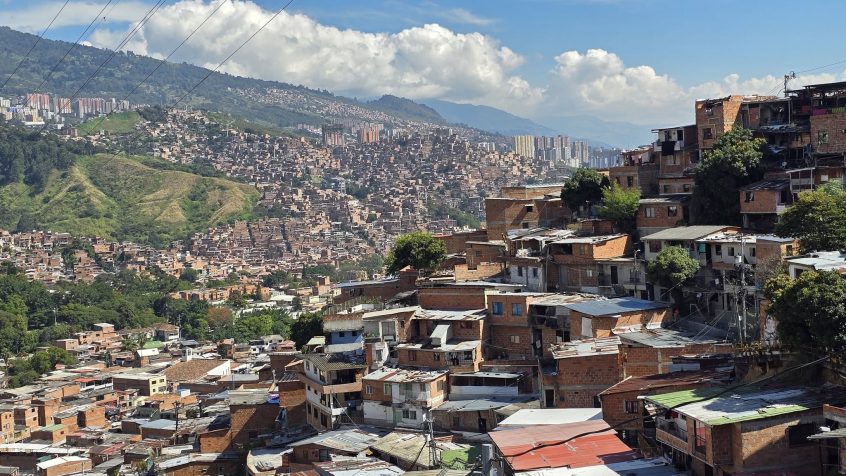Phil and I got off to an early start this morning. Our destination was Comuna 13, an area that has a wrenching history from the Pablo Escobar days. At that time, it was one of the most dangerous areas in the city, plagued by gang violence, drug trafficking, and clashes between armed groups. The neighborhood runs up the side of a mountain. Its steep hills and labyrinthine streets provided refuge for criminals and made law enforcement difficult. The homicide rates in the area were astronomical. Plus, the area leads directly to the main highway, providing easy transportation of guns, drugs, and money into the city and to the airport for export.
In the early 2000s the Colombian government ordered a large-scale offensive to take control of the area. The operation included thousands of soldiers and police. Using ground warfare, helicopters and tanks, there was intense fighting within the densely populated neighborhood. While the government declared the operation a success many civilians were caught in the crossfire. Despite its brutality, the operation marked a turning point for the area.
Now, Comuna 13 is a huge tourist attraction, but not because of its history, which I suspect most visitors don’t know. It’s famous for street art and fabulous views. This transformation came about through community initiatives, government investment, and urban renewal projects. One project was the installation of escalators to help residents and tourists get high into the neighborhood. I was extremely grateful for this, as there was no way I could have climbed the steep, narrow, cracked staircases that snake their way up the mountain.
The minute we stepped out of the taxi, we were set upon by a raft of guides wanting to give us a tour. We politely refused and set off on our own. We were just about the only tourists at 8:15. Before we got to the escalators, we had to climb a steep section of road, at one point it had to be nearly a 45-degree incline. All along the way was street art.
A series of six escalators climb high into the neighborhood. At each landing there are shops, bars, and restaurants (all closed on our way up). There were also amazing views of some of the newest art in Comuna 13, massive statues. Phil told me they are all recent, none of them were there when he first visited the area.
At the top, a path leads around the mountain. One of the first things I learned was to be very careful walking. Not because I’d trip or fall over the edge, but because pedestrians share the path with delivery trucks and motorcycles. I wondered how the vehicles got to the path; they surely didn’t go on the escalators, and I couldn’t detect any roads. But there must be, because the morning deliveries of beer, food and supplies were happening all around us.
We walked and stopped, sometimes to look at the art or spectacular views, sometimes to look at references to the area’s history. While much of the art wasn’t exciting, there were several superb artists.
When I needed a break to rest my back, we sat, rested, and observed the activity around us at vendors set up shop. It was a lively scene. The path seemed to go on and on as it circled the mountain, each bend providing a new view. At a fruit vendor I sampled a fruit I’d never tasted. Had I been interested, marijuana brownies were sold everywhere (as well as cannabis infused beer). Instead, we ate a frozen concoction of fruit and lime. It was delicious and refreshing. Every guide seemed to stop at the same vendor to buy samples for their group.
Three hours later we were on our way back down the mountain. Swarms of tourists were now heading up. I was glad Phil suggested we go early. By early afternoon, the whole area must be a mad house.
From there we grabbed a taxi and headed to the metro station. The Metro de Medellín has two train lines that cross the city from North to South and from Centre to West. It also has six gondola lines. These look similar to a ski lift and transport passengers high into the mountains for the price of a metro ticket (under $1). This ride anywhere else would cost a fortune.
We had jaw dropping views of the city and surrounding mountains. The gondola climbed, then dipped into a valley, then climbed again. Along the way we passed over desperately poor areas as well as wealthy ones. As the city grows, it goes ever higher. The valley is near capacity. Rather than get off at the top, we took a round trip.
From there, we boarded a train (didn’t need to pay anything additional). It’s an above ground system rather than a subway. The second we got on, I was offered a seat. The train, as Phil pointed out, was spotless. I kept wishing the NYC subways looked as good and the passengers were as polite.
We exited near the sports complex, the roofline built to resemble the surrounding mountains. For lunch we purchased arepas at a kiosk. We sat on a bench beneath a flowering tree, with petals raining down upon us as we ate. It was delightful.
By that point I was tired, so I returned to my hotel and Phil went home. We met for dinner and were joined by Phil’s friend Jim for a drink. We had a lively conversation.
All-in-all, another wonderful day.

